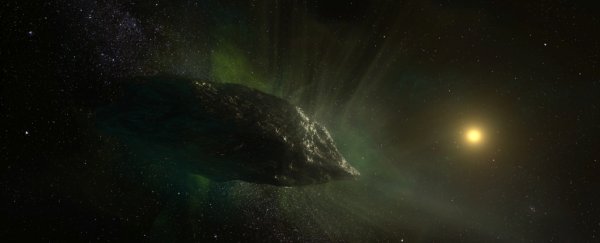When the first known comet from interstellar space was spotted traversing the Solar System in late August of last year, astronomers snapped to attention. 2I/Borisov was an extraordinarily rare opportunity to study the formation of comets around other stars.
In those initial measurements, 2I/Borisov seemed a heck of a lot like comets from the outer Solar System. But a new analysis has revealed that our visitor is much more alien than we thought after all.
In the cloud of gas that the comet started to emit as it neared the Sun, a team of astronomers detected more carbon monoxide than they've ever seen in a comet within 300 million kilometres (180 million miles) of the Sun.
"This is the first time we've ever looked inside a comet from outside our Solar System," said astrochemist Martin Cordiner of the Catholic University of America, "and it is dramatically different from most other comets we've seen before."
2I/Borisov wasn't the first known interstellar object in the Solar System; that was 'Oumuamua, whose identity is still uncertain. However, 2I/Borisov is the first known comet, which made it very exciting indeed.
Comets spend most of their time in the cold outer reaches of a planetary system; at least, that's our experience with the Solar System.
Short-period comets formed in the Kuiper Belt, the debris field where Pluto lives, which astronomers believe formed much closer to the Sun and migrated outwards, while long-period comets formed in the Oort Cloud, which is wayyyyy out farther still (but probably formed closer to the Sun than the Kuiper Belt).
As a consequence, comets are like time capsules, changing very little from the time they were formed. It's therefore thought that these peregrinating chunks of rock and ice can tell us a lot about the composition and processes of early planetary systems.
We don't know much about how this happens in other planetary systems, but we're dying to find out - not least because comets raining down on early Earth could have been a major ingredient in kickstarting life, carrying water and other ingredients necessary for the process.
So, as 2I/Borisov sped away from the Sun after its December 8 perihelion, astronomers made a careful study of its coma, the cloud of gas that envelops a comet as it nears the Sun, and the ice inside sublimates due to the heat.
They used the Atacama Large Millimeter/submillimeter Array in Chile to obtain detailed spectra and images of the comet as it journeyed through the inner Solar System. These break down the wavelengths of the light bouncing off the comet, which allows scientists to look for wavelengths absorbed or emitted by specific molecules.
2I/Borisov's coma contained hydrogen cyanide; this is fairly typical for Solar System comets, and 2I/Borisov was emitting it in normal amounts. But the CO levels made the team do a double take.
Although most Solar System comets do contain CO, in wildly varying amounts, 2I/Borisov had way more than we usually see - between 9 and 26 times more than the average Solar System comet, the researchers said.
Astronomers aren't sure why Solar System comets have such varying proportions of CO, but they think it may have to do with the temperature at which the comet formed. The colder the temperature, the greater the concentration of CO. This means, the researchers believe, that 2I/Borisov formed somewhere very cold indeed.
"The comet must have formed from material very rich in CO ice, which is only present at the lowest temperatures found in space, below -420 degrees Fahrenheit (-250 degrees Celsius)," said planetary scientist Stefanie Milam of NASA.
This region around another star would be analogous to the current distance of the Kuiper Belt - but, because the rocks in the Kuiper Belt are thought to have formed closer to the Sun, the CO levels in its comets are much lower than if they formed at the current distance.
That means 2I/Borisov doesn't really fit with the comet formation models we've based on the Solar System. It's possible that it's a chunk of CO-rich dwarf planet. Or it could have an insulating layer that keeps other volatiles frozen while CO sublimates.
It defies easy explanation, but 2I/Borisov has reached the end of the line in the Solar System, and has been observed breaking into pieces. This could tell us a lot about the interior composition of the comet, and help rule out or confirm the team's hypotheses.
But high cometary CO levels aren't without precedent, either. A comet discovered in 2016 - C/2016 R2 (PanSTARRS) - was found to have CO levels dozens of times higher than 2I/Borisov's.
This was interpreted as an origin in the Oort Cloud, but 2I/Borisov raises the possibility that C/2016 R2 (PanSTARRS) could have had an interstellar origin too. That's a really intriguing idea, but we may be waiting a while for answers.
"2I/Borisov gave us the first glimpse into the chemistry that shaped another planetary system," Milam said. "But only when we can compare the object to other interstellar comets, will we learn whether 2I/Borisov is a special case, or if every interstellar object has unusually high levels of CO."
The research has been published in Nature Astronomy.
